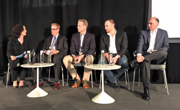 The third annual Retail Innovation Conference, hosted by Retail Touchpoints, was held May 8 – 10th at the elegant Apella in New York City. The 2017 conference (#RIC17) brought together a lively mix of retail executives, analysts, start-ups, and influencers all in the name of positive industry change and growth. Opening day kicked off with store tours around NYC to see innovators in action inside the Westfield World Trade Center mall space. The following two days were chock full of networking, panel discussions, and content presentations all topped off with an awards ceremony recognizing accomplished movers and shakers in retail. From the presentations, discussions, and panels, it was clear that our industry is undergoing a great period of innovation and development. Wayne Duan, director of digital commerce for Walgreens, a conference speaker, and winner of an Innovation Award, best summed it up when he asked the group, “Do you fear change? Or do you fear not changing?” Here are Independent Retailer’s top four insights and predictions from the Retail Innovation Conference:
The third annual Retail Innovation Conference, hosted by Retail Touchpoints, was held May 8 – 10th at the elegant Apella in New York City. The 2017 conference (#RIC17) brought together a lively mix of retail executives, analysts, start-ups, and influencers all in the name of positive industry change and growth. Opening day kicked off with store tours around NYC to see innovators in action inside the Westfield World Trade Center mall space. The following two days were chock full of networking, panel discussions, and content presentations all topped off with an awards ceremony recognizing accomplished movers and shakers in retail. From the presentations, discussions, and panels, it was clear that our industry is undergoing a great period of innovation and development. Wayne Duan, director of digital commerce for Walgreens, a conference speaker, and winner of an Innovation Award, best summed it up when he asked the group, “Do you fear change? Or do you fear not changing?” Here are Independent Retailer’s top four insights and predictions from the Retail Innovation Conference:
Many major news outlets have reported on the “Retail Apocalypse.” Kasey Lobaugh, Chief Retail Innovation Officer for Deloitte, argued against that adage. Retail is not dying, it is changing, but not because of the reasons many of these journalists and pundits have been blaming. Traditional mall retailers are struggling, but not because of Amazon or even because more consumers are shopping online. Deloitte’s data shows that brick and mortar and online shopping dollars are both increasing at the same speed. And — importantly — in-store sales still hold a large majority of overall dollars spent. Those dollars are just not going to the same box and chain stores as before. Because consumer behavior is changing, retailers are changing. Lobaugh explains that people still spend money on things in which they find value. He continues that, as retailers, we need to build “scarcity or perceived scarcity,” to create value. For independent retailers and startups, crafting unique experiences and offering one-of-a-kind products are what we do best. The barrier to entry to gain consumer attention and dollars has never been lower.
Strategic Partnering
Wayne Duan told the crowd, “Direct commerce sales are just the tip of the iceberg.” He continues that “the notion of convenience is being stretched,” and retailers need to leverage strategic partnerships in order to meet convenience demands. One example he provides is the “decoupling of lead generation and fulfillment.” Walgreens is partnering with platforms such as Post Mates to fulfill order deliveries. Another example of this type of thinking is apparel retailers who also sell their clothing through Nordstrom. In other words, don’t wait for shoppers to come to you. Instead of taking an isolationist approach to business, build bridges to put your products where they consumers already looking.
On the last day of the conference, female executives from Google, Elizabeth Arden, Remodista, and ?What If! Came together for a panel titled “Women Fueling Change: Understanding The Value Women Executives Bring To The Bottom Line.” Kelly Stickel, founder, and CEO of Remodista, a think tank that provides insight, education, and innovation to global brands and retailers, presented data showing that companies who are inclusive and have influential female executives are more profitable. She defines inclusion as “the act of making everyone feel welcome.” Striving for inclusivity, of course, has its own merits. But studies show that overall, companies whose executive mix includes 30 percent women outperform companies with no female executives by 15 percent.
Women are influencing retail both from the outside and within. Swan Sit, VP of Global Digital for Elizabeth Arden notes that retail is one of the only industries that has influencers who can outperform paid media. She advises that if retailers can find their biggest fans and brand advocates and loop them into the conversation, these influencers can be a brand’s most effective marketing tools.
Customer Centric
The underlying theme of the three-day conference was customer centricity. For as long as retail has existed, there has been some form of consumer friction. Stores were far away, shoppers had to wait in line, items are out of stock, and store policies favor the brand and not the shopper. Shoppers dealt with these frictions because there really was no other option. Now, that is not the case. Technology is bringing endless choices, options, and speed to consumers. Instead of shoppers bending to the constraints of the retailer, healthy competition via start-ups and independent retailers are forcing the industry as a whole to quickly adapt to meet the needs of consumers. As Wayne Duan explained, if you don’t remove the friction, competitors will do it for you.


